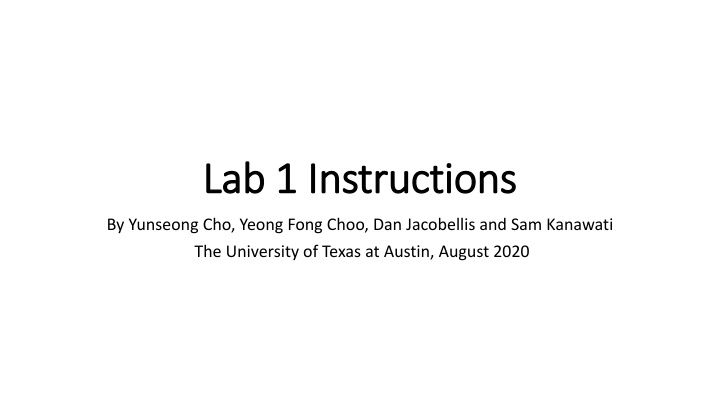
Effective DSP Lab Instructions for MATLAB Analysis
"Learn key concepts of signal processing using MATLAB through practical lab work with step-by-step instructions on creating signals, spectrum analysis, and timing measurements. Enhance your understanding of DSP techniques with clear guidelines and coding examples."
Download Presentation

Please find below an Image/Link to download the presentation.
The content on the website is provided AS IS for your information and personal use only. It may not be sold, licensed, or shared on other websites without obtaining consent from the author. If you encounter any issues during the download, it is possible that the publisher has removed the file from their server.
You are allowed to download the files provided on this website for personal or commercial use, subject to the condition that they are used lawfully. All files are the property of their respective owners.
The content on the website is provided AS IS for your information and personal use only. It may not be sold, licensed, or shared on other websites without obtaining consent from the author.
E N D
Presentation Transcript
Lab 1 Instructions Lab 1 Instructions By Yunseong Cho, Yeong Fong Choo, Dan Jacobellis and Sam Kanawati The University of Texas at Austin, August 2020
General Guide on Lab Reports Laboratory Webpage : http://users.ece.utexas.edu/~bevans/courses/realtime/lectures/laboratory/c6748winDSK/index.html Each lab is worth 40 40 points points. Lap report grading consists of 30 points for the reported contents and accuracy. The remaining 10 points are for attendance and participation of lab recitation. Lab recitation will be held at the beginning 35 to 40 minutes of each lab and attendance and participation is compulsory. Report must must be be in in typed typed and and submitted submitted on on canvas canvas. Hand-drawn diagrams should be clear and scanned. Report must brief and concise and should should be be less less than than 10 10 pages pages. Try to minimize white space created due to inserting screenshots. Please ask for clarity if more pages are needed. Empty front pages are not preferred! Screenshots of oscilloscope waveform and computer screenshots must be clear and cannot cannot be be obtained obtained through through phones phones camera camera. We recommend using Save Save function on the oscilloscope through USB drive. For partial credit, please submit all work even if they are incomplete or incorrect.
DSP in MATLAB Creating continuous-time sinusoidal signal Create continuous-time vector, t with range of 1-sec and time-spacing of fs = fs = 1000 1000Hz Hz, , Ts=0.001sec Ts=0.001sec. Please exclude the last data point, i.e., the end point becomes 1-1/fs Create a sinusoidal signal, xt with frequency of 100 Hz and same size of t Plot xt on a figure. Hint: use plot function. Label the plot with x-axis , y-axis , and title Use t and xt vectors to obtain the values of xt at time instant, t = 0.32-sec, t = 0.64-sec using find() find(). Provide your code and figure in lab report. Sampling continuous-time sinusoidal signal Sample the above continuous-time vector, xt at every 0.008-sec and name it xn . Overlay xn on the same figure containing xt . Hint: use stem function. Provide your code and figure in lab report.
Spectrum Analysis in MATLAB Discrete Fourier Transform (DFT/FFT) Compute the DFT of the signal xt using fft and fftshift. Store the result in a variable yt. Convert the complex DFT values to decibels using the log10 and abs functions, then store in a new variable f ?? 2,?? 2 ?? ? with spacing of ?? Plot magnitude spectrum over the frequency range of ?. Provide your code and figure in lab report. Discrete-Time Fourier Transform (DTFT) Apply the freqz function to the signal xt and compare the result. freqz will automatically plot the result. Provide your code and figure in lab report.
Timing and Measurements in MATLAB Stopwatch Timer Create a new script and begin with the tic function to start the stopwatch timer. Create two large matrices A and B using the rand function, i.e. A=rand(5000) Multiply the two matrices and store the result in a variable C End the script using the toc function to print the elapsed time. Provide your code and timing measurement in lab report. Profiler Turn on the profiler using the CPU timer using profile on timer cpu . Create a function that performs the same matrix multiplication C=A*B and make a call to the function. Stop the profiler using Profile off and view the results with the command profile viewer Provide your code and profiler output in lab report.
Memory Measurements in MATLAB View memory in Workspace Create two large matrices A and B using the rand function, i.e. A=rand(5000) Locate the variables in your MATLAB workspace. Verify that the size is correct. Right click in the workspace window to enable Bytes in the variable display Report the size of your matrix in bytes in your lab report. View memory using whos Run the whos command and verify that the variable sizes matches the display in the workspace Apply the whos function to a single variable and save the output, i.e. var_info = whos( A ) Access the bytes field of the output and divide by 106 to determine the size in megabytes. Report the size of your matrix in megabytes in your lab report.
Assignment Questions Please complete the following assignment questions and submit as Lab 1 report, except Q4 which is mainly for the C implementation http://users.ece.utexas.edu/~bevans/courses/realtime/lectures/laboratory/c6748winDSK/lab1/Lab1Assignment.docx
